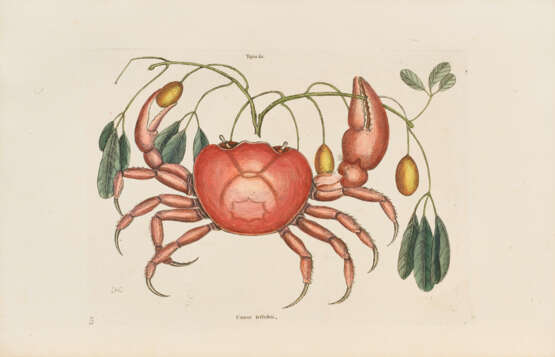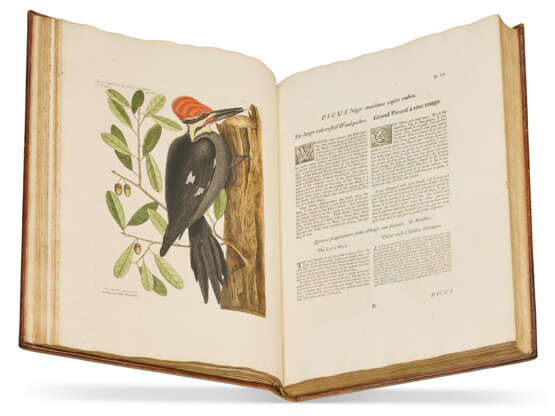ID 1236352
Lot 121 | The Natural History of Carolina, Florida and the Bahama Islands
Valeur estimée
$ 400 000 – 600 000
First edition. A magnificent copy of “the only attempt to record the natural history of an American colony in colonial times” (Jackson) and with the extremely rare broadside prospectus.
Little is known of Catesby's early years, but it seems that he met the naturalist John Ray during his childhood which triggered his interest in natural history. After his father's death in 1712, Catesby went to live in Virginia with his sister, Elizabeth, and her husband. During this time he sent seeds and botanical specimens to a Hoxton nurseryman, Thomas Fairchild, and this generated much interest in scientific circles. Catesby returned to London in 1719, and in 1722, he was recommended to head a Royal Society funded plant-hunting expedition to Carolina. By October of that year he was sending back to London significant quantities of dried plants, many of which were new to science. Sir Hans Sloane was particularly interested in the expedition and specimens were sent directly to him by Catesby. Catesby seems to have soon widened his interests to include zoological specimens; in a letter of 10 May 1723 to Sloane, he asks for “another case of bottles for snakes and boxes for birds” (Sloane MSs 4046, ff.352-53). After four years in the Americas, Catesby returned to London in 1726, and proceeded to devote the next 21 years to the publication of The Natural History of Carolina. Catesby drew the map from his own knowledge and engraved the majority of the plates; and, at least for the first copies, he is believed to have colored the plates himself. The first edition was issued by Catesby in parts, completed in 1747, and became the earliest color book on American birds. The legacy of this work, however, transcends both being the earliest American ornithology and the only colonial-era book of natural history. Catesby's masterpiece is also a seminal work in itself. “Mark Catesby made a valuable and important contribution to ornithological illustration. He was confident enough to break new ground—to portray his birds more naturally than before, with foliage backgrounds, and to adopt the folio format. He depicted the natural history of one area in its entirety, and often drew from living models” (Jackson). Hunt calls this work "a fundamental and original work for the study of American species.”
Such was its importance and popularity that a second edition was required a few years after Catesby’s death and yet a third in 1771, still before the American Revolution. This level of commercial success was highly unusual, to say the least, for such a lavish and expensive publication. The first edition was the only one published in Catesby’s lifetime and this copy has beautiful, crisp impressions of the plates, superlative color, and several points indicating early issue. Recent scholarship by Leslie Overstreet shows that the type was reset in the first volume at least three times, indicating that Catesby kept the number of copies printed close to the running number of subscribers for the first twelve years of publication. Only with the second volume did he have enough confidence to authorize a sufficient print run. The present copy has early variants with errors that are either uncorrected (“Red-Ey’d Flycatcher” on p.54) or corrected by pasted slips rather than resetting (“Bignonia” on p.37). When this copy last appeared at auction almost 17 years ago it obtained a record price for a printed work by Catesby; a record which still stands today according to the records of RBH.
The broadside prospectus present here was printed circa 1729 to solicit subscribers to fund the production of the books. Catesby had no patron and was unwilling to cede publishing rights to a printer or bookseller. In the "almost a dozen" extant copies identified by Overstreet, there are three separate printings. This is the last of the three, with "Macclesfield" correctly spelled and referring to the original nurseryman, Thomas Fairchild, in the past tense. The prospectus provides essential information on Catesby's plans for publication, and his own view of the salient selling points, which are still true today. Viz., that the author was himself the eye-witness and that he took incredible care with the pictorial depictions: "As figures convey the strongest Ideas, and determine the Subjects treated of in Natural History, the Want of which hath caused so great Uncertainty in the Knowledge of what the Antients have described barely by words; in order to avoid such Confusions, we shall take care to exhibit every thing drawn by the Life, as well as described in the most particular manner." Dunthorne 72; Fine Bird Books (1990), p. 86; Hunt 486; Overstreet "The publication of Mark Catesby's The natural history of Carolina, Florida and the Bahama Islands," in The Curious Mr. Catesby (2015), p. 155ff.
Three volumes including Supplement, folio (517 x 354mm). 220 hand-colored etched plates after and by Catesby and mostly signed with his cipher—excepting vol. II, pls. 61 and 96 by G.D. Ehret—including double-page hand-colored engraved map in vol. II. (Vol. I with some scattered foxing and a narrow dampstain to fore-edge, vol. II and Supplement with only occasional spots, short marginal tears—mostly repaired—to about 6 pls. and 6 text leaves, the longest of which is 1.5” (pl. I.3); some pls. in vol. II bound out of order but all present (1-58, 63-66, 59-61, [62, misprinted as 80], 67-79, [80, misprinted as 62], 81-100). Title-pages printed in red and black in English and French, text in parallel columns of English and French, with the dedication leaf in each volume (vol. I: Queen; vol. II, The Princess of Wales) and “List of the Encouragers” leaf in vol. I (complete with all 155 subscribers including the Earl of Illey). “An Account of Carolina, and the Bahama Islands” with an etched headpiece plate by Catesby and historiated woodcut initials and tailpiece bound following plates and descriptive text of vol. II, 3-leaf index to vols. I and II bound at end of vol. II, single-leaf index to Appendix bound in Supplement. Duplicate “Account” and 3-leaf index bound at the start of the Supplement. First 20 text pages of vol. II with page numbers altered to 1-20 from 120-140. Contemporary diced russia (vols. I-II) and contemporary calf (Supplement) gilt-ruled, spines gilt, all three with green morocco lettering pieces (Supplement rebacked to style preserving lettering pieces; some rubbing and minor repairs to extremities). The letterpress broadside measures 850x440mm (small spot, binding remnants on left edge, a couple of tiny marginal wormholes and faint mat-shadow); matted and framed. Provenance: Brooks McCormick (his sale, Sotheby’s New York, 5 October 2007, lot 13).
| Artiste: | Mark Catesby (1683 - 1749) |
|---|---|
| Lieu d'origine: | Angleterre, Etats-Unis |
| Catégorie maison de vente aux enchères: | Livres imprimés |
| Artiste: | Mark Catesby (1683 - 1749) |
|---|---|
| Lieu d'origine: | Angleterre, Etats-Unis |
| Catégorie maison de vente aux enchères: | Livres imprimés |
| Adresse de l'enchère |
CHRISTIE'S 8 King Street, St. James's SW1Y 6QT London Royaume-Uni | |
|---|---|---|
| Aperçu |
| |
| Téléphone | +44 (0)20 7839 9060 | |
| Commission | see on Website | |
| Conditions d'utilisation | Conditions d'utilisation |























